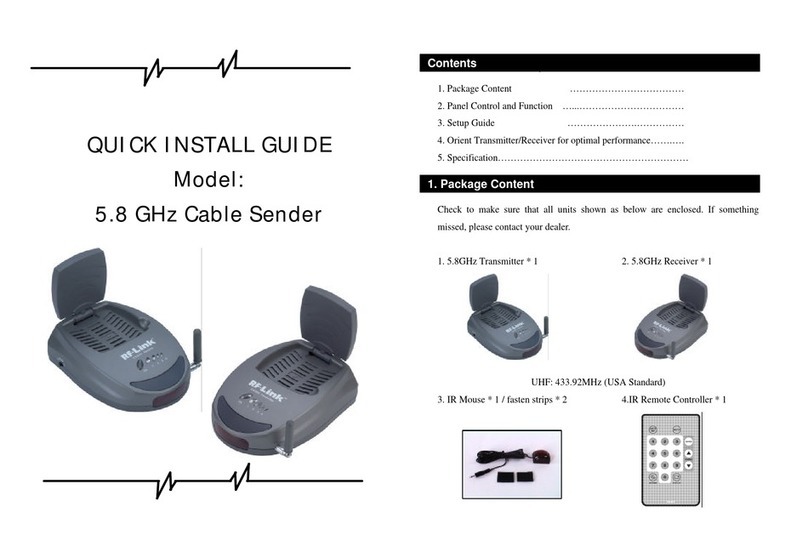4.2 After setup your transmitter and receiver,the first time to enjoy CATV on
CableSender,It needs to scan and find the available channels . Please
follow procedure below :
zThe first step : turn on your TV set and Switch to AV IN.
zThe step 2 : power on the cable sender (Transmitter and Receiver ) and
select the same channel you like .
zThe step 3 : push “CATV/AV “ button on IR Remote Controller to
switch Cable Sender to CATV mode.
zThe step 4 : Programming the cable tuner using “search” button
on IR Remote Controller to automatic scan and find the available
channels , and memorize it.
zThe step 5 : Using CH+/CH- button on IR Remote Controller for
paging up/down channel , using “NUMBER” button to select TV
channel you like.
For optimal performance, both the audio/video and remote control antennas should
be carefully oriented as described below. For maximum transmitting range, try to
minimize obstacles (e.g. your TV or other electronics, large furniture) where
between the transmitter and receiver.
Orients the 5.8GHz A/VAntennas
Orients the UHFAntennas
In order to obtain optimal performance of the remote control extender, the remote
control antennas should also be oriented at a right angle to an imaginary line
drawn between the transmitter and receiver. If your remote control extender is not
working satisfactorily, rotate the remote control antenna on either the transmitter
or receiver 90 degrees so that it is still perpendicular to the path between the units.
(See Fig-4)
If you notice improved performance, keep this orientation. Rotating the antenna on
both units should have no effect.
5. Orient Transmitter/Receiver for optimal performance
The system delivers high-quality audio and
video by using directional antennas, which must
be oriented in the best ways. The antennas are
designed to be able to vertically and horizontally
pivot and rotate in almost any direction.
In most situations, the flat-pitted face of the antennas on both the transmitter and
receiver should be facing one another and perpendicular (at a right angle) to an
Fig-2
Fig-3
Fig-1
imaginary line drawn between the two units. Three examples are shown as Fig-1,
Fig-2 and Fig-3. Since all homes are different, for optimal reception, additional
slight pivots or rotations may be necessary. If the transmitter and receiver are
less than 10 feet apart, suggest that the antennas are lying on their casings since
the distance is so short.
Fig-4
06 07






















